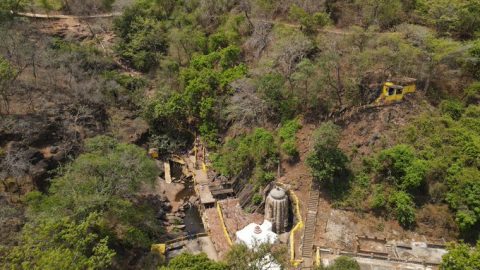Biodiversity Heritage Site Tag For Odisha’s ‘Ayurvedic Paradise’ Gandhamardan Hills

Bhubaneswar: Three decades after a highly successful people’s resistance against bauxite mining, the Odisha government has accorded Biodiversity Heritage Site (BHS) tag to Gandhamardan Hill Range in Bargarh and Balangir district, the third such spot in the state after Mahendragiri hills in Gajapati and Mandasaru gorge in Kandhamal district.
According to a notification issued by Forest, Environment and Climate Change Department, an area of 18,963.898 hectare of Gandhamardan Hill (Gandhamardan Reserve Forest), including 12,431.8 ha (Bargarh) and 6,532.098 ha (Balangir), has been declared as BHS of Odisha.
Gandhamardan hill range is considered as ‘Ayurvedic paradise’ of Odisha’ where traditional knowledge holders have been collecting wild medicinal plants to treat different diseases and ailments. The hills also have historical monuments such as the Nrusinghanath temple located on the northern slope and Harishankar temple on the southern side with rich cultural significance.
However, the rich biological resources of the cultural landscape are under pressure due to anthropogenic and climatic factors, while the traditional knowledge associated with the bio-resources is also declining, necessitating long-term protection and conservation of the hill range, the department underlined.
Notably, the Odisha Biodiversity Board had sent a proposal to the state government last year to declare the threatened hill range in the Gandhamardan reserve forest area as a BHS for long-term protection, conservation and management of biological resources of the hill. A detailed inventory of the flora and fauna in the hill ecosystem spread over 189.639 sq km within the forest ranges of Harisankar, Lathore and Patnagarh in Balangir and Nursinghnath and Paikamal in Bargarh was then carried out.
The Board has found 1,700 species of plants and animals, 1,200 species of plants and 500 species of animals, in the hill ecosystem. Around 209 trees, 135 shrubs, 473 herbs, 77 climbers and 300 species of medicinal plants have been recorded in the hill ecosystem of which 18 species are threatened and one species is endemic.
About Gandhimardan
Fifteen years ago, the Gandhamardan hills, rich in biodiversity and bauxite equally, were the platform for one of India’s most vocal people’s struggles to conserve forests and livelihood. A five-year sustained campaign by the local people saw BALCO wind up its operation to mine 213 million tonnes of bauxite.
The Botanical Survey of India has reported the existence of 220 plant species of medicinal value. Local people, however, claim that there are more than 500 species of medicinal plants in this area. The flora of the buffer zone is the most vulnerable. Many medicinal plant species such as Clerodendron indicum , Rauvolfia serpentina and Plumbago zeylanica , which were once available in plenty, have become scarce. A study by G Panigrahi of the Botanical Survey of India in 1963 recorded 2,700 angiosperms and 125 species of important medicinal plants, out of a total of 220 species of medicinal and quasi-medicinal and economically-vital plants.
Besides, more than 100 traditional healthcare practitioners live in and around the Gandhamardan hills. These practitioners provide medical facilities to about 50,000 tribal people. There are two Ayurvedic colleges and hospitals on both sides of Gandhamardan, one in Bargarh district and the other in Balangir.
Legends has it that medicinal plants from Gandhamardan, as the epic Ramayana says, saved the life Laxman, thus making it possible lord Ram’s victory over Ravana, a symbol of devil.
BHS
Biodiversity heritage sites are well-defined areas under the National Biodiversity Authority that are unique, ecologically fragile ecosystems – terrestrial, coastal and inland waters and, marine – having a rich ecosystem comprising any one or more of the following components: richness of wild as well as domesticated species or intra-specific categories, high endemism, presence of rare and threatened species, keystone species, species of evolutionary significance, wild ancestors of domestic/ cultivated species or their varieties, past pre-eminence of biological components represented by fossil beds and having significant cultural, ethical or aesthetic values and are important for the maintenance of cultural diversity, with or without a long history of human association with them.

Comments are closed.